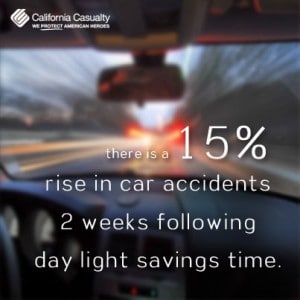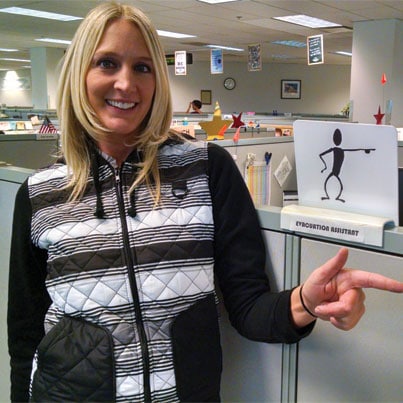by California Casualty | Safety |

There’s a lot of debate about the spring time change; it’s nice to get more daylight but the effects may not be worth it – kids are tired and cranky and many of us are exhausted from losing the hour of sleep. If you are feeling “out of sorts” the week after the change to Day Light Saving (DST), you are not alone. Many sleep experts say messing with our sleep can cause some real health concerns for the heart and the brain.
A 2012 University of Alabama study confirmed the results of an earlier study in Sweden that found a spike in heart attacks the first week of DST.
Numerous studies have shown a 10 to 15 percent rise in traffic accidents the two weeks following the “spring forward” in time.
Educators
Students appear to be affected too. A 2009 study in the journal Sleep Medicine found that, overall, kids were sleepier than usual during the day for three weeks after the time change. The authors of the study suggested that no tests should be given during the first week or two after the switch to DST.
Shift workers – police officers, firefighters, EMTs and nurses – are not immune either.
Tired Blues for the Men and Women in Blue
A study in the Journal of American Medical Association (JAMA) found 40 percent of law enforcement officers had a sleep disorder and just under half admitted to falling asleep while driving, a quarter of those reported doing so at least one or two times per month. The percentage of drowsy driving increased for officers on night shifts. With Daylight Saving and the loss of a precious hour of sleep, already disjointed sleep patterns can be even more affected. The JAMA study concluded that a sleep deprived mind was found to produce officers with a higher rate of reporting serious administrative errors, making safety violations attributed to fatigue, exhibiting anger, falling asleep while driving or during meetings, and absenteeism.
Fatigued Firefighters and First Responders
A study by the International Association of Fire Chiefs (IAFC) warned that that “sleep deprivation [among firefighters] may be responsible for the disproportionally higher fireground injury rates observed early in the morning hours.” It also showed that fatigue when driving may increase the risk of crashes following work hours. Again, switching to DST appears to exacerbate the problem.
Nodding Nurses
Do you know a nurse who isn’t tired? In a study of hospital staff nurses, almost 600 out of 900 surveyed reported at least one episode of drowsy driving and 30 nurses admitted they experienced fatigued driving following every shift they worked. For nurses who worked only night shifts, the percentage rose to almost 80 percent. For many, the time change only makes the problem worse. A sleep deprived mind is not good for patient care and workplace harmony.
Sleep Tips
Here are some possible solutions from WebMD and the American Academy of Sleep Medicine to relieve the effects of DST:
- Expose yourself to bright light during waking hours and no light at nighttime
- Practice good sleep “hygiene:” limit or reduce caffeine and alcohol, create calming rituals before bed to gradually relax and, exercise several hours before bedtime
- Take low doses of melatonin, a substance that helps regulate cycles of sleep
- Take the Monday after the time change off if you feel too sleepy to work or drive
The good news is that within a few weeks, our bodies and brains begin to adjust to the new sleep schedule.
Don’t Forget the Smoke Detectors
This is also the time to replace the batteries in smoke detectors and carbon monoxide alarms. Fire officials say working smoke and carbon monoxide alarms save lives and protect property.
Get Protection
The switch to Daylight Saving, with more tired drivers on the road, should be a reminder that now is a prudent time for a policy review to make sure you have the right auto and home insurance protection at the best value. Call today and talk to a California Casualty advisor at 1.800.800.9410, or visit www.calcas.com.
Read more about the effects of the spring time change at
https://articles.mercola.com/sites/articles/archive/2013/03/07/dst-change-increases-heart-attack.aspx
https://www.sleepeducation.com/news/2013/03/11/why-accidents-increase-after-spring-forward-to-daylight-savings
https://jama.jamanetwork.com/article.aspx?articleid=1104746&resultClick=3
https://www.iafc.org/sleep
https://www.ncbi.nlm.nih.gov/books/NBK2645/
by California Casualty | Safety |

It happens every fall; as the first frigid Polar air makes its plunge into the U.S., many of us are scrambling to find the hats, gloves and extra layers we put away for summer.
Hopefully you have had your HVAC system checked and replaced the filters for maximum warmth on these cold days. Here are some more simple tips from Wikihow.com to keep you warm while helping you save on the heating bill:
- Warm rooms by opening window shades when the sun is shining
- Hang cheap, clear shower curtains to block cold air while allowing the sun’s heat in
- Close off unused rooms
- Use rugs and carpets over cold floors
- Cooking with the oven adds heat to your home
- Drink hot liquids
- Wear layers
- Exercise
- Snuggle with a pet
- Get a heating pad or electric blanket
Remember, too, that running ceiling fans in reverse pushes warm air down to the ground.
To help keep you safe, the American Red Cross is launching a new campaign to reduce the risk of home fires that usually increase this time of year. The most essential part of the campaign is to have Americans install and check their smoke alarms and for each household to practice fire drills. The Red Cross also urges everyone to follow these common sense heating safety tips:
- Keep ignition sources like paper, clothing, bedding and curtains at least three feet away from space heaters, stoves and fireplaces
- Never leave heaters and fireplaces unattended
- Place space heaters on a level hard surface like tile floors and away from rugs
- Look for models that have automatic shut off features
- Have wood and coal stoves, fireplaces, chimneys and furnaces professionally inspected and cleaned once a year
Now is also a great time to make sure your family has an emergency kit. According to Ready.gov, it should have enough food and water to survive for a minimum of three days and should also contain:
- A battery powered radio
- Flashlight
- Lots of extra batteries
- First aid kit
- Formula and diapers if you have an infant
- Moist towelettes, garbage bags and plastic ties for sanitation
- Plastic sheeting and duct tape to shelter in place
- Wrench or pliers to turn on and off utilities
- A can opener
- Any essential medications
- Household chlorine bleach to disinfect and treat water
You can find numerous other winter safety preparations and tips at the California Casualty Resources Page. And don’t forget to make sure your vehicle is ready for winter too.
Now is a really good time to make sure your home or apartment is fully protected for fire, ice, wind and other winter damage. Call a California Casualty advisor today for a policy review and to see what discounts you qualify for at 1.800.800.9410 or at www.calcas.com.
Sources for this article:
https://www.wikihow.com/Stay-Warm-at-Home-Without-a-Heater
https://www.redcross.org/prepare/location/home-family/prevent-home-fires/
https://www.ready.gov/build-a-kit
https://mycalcas.com/2012/11/preparing-your-car-for-winter/
by California Casualty | Safety |

Today is America’s PrepareAthon, the culmination of FEMA’s National Preparedness Month. The idea is for individuals, communities and organizations to be prepared for six specific hazards:
The message is that families, businesses and neighborhoods should know their risks, have a plan of action and prepare survival kits.
It got us thinking; “How prepared is California Casualty?”
First, client and employee safety is paramount at California Casualty. Security systems are in place at all our service centers. The company conducts drills for fires and other possible occurrences – complete with trained safety personnel who help with evacuations and account for employees when safety zones are reached. These evacuation assistants are trained in first aid, CPR and the use of automatic electronic defibrillators (AED).
California Casualty has implemented a business continuity and recovery plan should an earthquake, flood, fire, tornado, power outage or winter storm adversely affect operations at one or more of our service centers. Managers carry contact information for every employee so they can be reached in an emergency. Systems are in place so that key personnel can operate remotely and phone and data systems can be shifted to service centers that have not been impacted. This minimizes inconvenience and potential disruption to policy holders.
Yearly table-top disaster scenarios are run to make sure managers know the procedures and backup systems they can utilize. In worse case scenarios, staff can be temporarily relocated to other services centers to maintain the continuity of service to clients. With service centers in Kansas, Colorado, Arizona and California, California Casualty has the redundancies and virtual call routing to maintain operations even if a service center is completely down.
California Casualty also has an emergency outreach plan for clients who may be affected by a disaster. Calls are made to areas that have been hit by flood, fire, tornado, hurricane or flood to make sure our insureds are okay and to expedite help with claims. Our Field Managers and Claims personnel respond to disaster areas to make contact with those insured with California Casualty and aid in their safety, relocation and recovery.
California Casualty works very hard to keep client information and data protected with numerous advanced data security protocols and monitoring. As an added layer of safety, every auto and home insurance policy includes free 911 ID Theft Protection.
Preventing tragedies is also a main concern. California Casualty strives to help our policy holders prepare for various disaster scenarios with many links and preparedness tips at our website’s Resources page.
Are you prepared? Today is the day to make sure with America’s PrepareAthon.
by California Casualty | Safety |

Think about how many things you do using your smartphone, your laptop and your tablet. Whether it’s banking, checking on your child’s grades or shopping for new clothing, your passwords, accounts and other information are vulnerable. Now, there are two new warnings about security breaches involving computers and cell phones that highlight the real threat of criminals trying to steal our personal information.
Reuters is reporting that 90 percent of the world’s smartphones are at risk of password theft, stolen data and even allowing hackers to take over control of the device. The flaw affects Apple, Google Android and Blackberry devices prone to an obscure industry standard that controls everything from network connections to how user identities are managed. A separate threat, called “Fake ID,” targets three-quarters of older Android systems, allowing malicious applications to trick trusted software from Adobe, Google and others without any user notification.
And, if that’s not enough bad news, the New York Times recently ran an expose of a suspected Russian crime ring that may have stolen internet credentials, including 1.2 billion user names and password combinations, scoured from 420,000 websites. The criminals targeted any website they could hack from giant corporations to small businesses.
There are steps you can take to protect your personal information. The U.S. Federal Trade Commission is actively involved in ID theft protection. Some of their recommendations include:
- Lock your financial documents and records in a safe place at home
- Keep our wallet or purse in a safe place at work
- Shred all receipts, credit card offers and applications, insurance forms, physician statements, bank statements and other financial documents
- Don’t open files, click on links or download programs sent by strangers
- Use complex passwords on computers, laptops and websites and change them often
Credit experts like ID Theft 911 also advise consumers to check your bank statement weekly, request a receipt for any purchase you make and run a free credit check annually.
An extra sense of security comes with every auto and home insurance policy from California Casualty: Free ID theft protection and resolution services from ID Theft 911. Make sure your property and identity are protected by calling a California Casualty advisor today, 1.800.800.9410.
Sources for this article:
https://www.consumer.ftc.gov/features/feature-0014-identity-theft
https://www.reuters.com/article/2014/07/31/us-mobilephone-cybersecurity-idUSKBN0G01RI20140731
https://idt911.com/en/KnowledgeCenter.aspx
https://thehackernews.com/2014/07/android-fake-id-vulnerability-allows_29.html
https://finance.yahoo.com/news/russian-gang-amasses-over-billion-201533714.html
by California Casualty | Safety |
There is nothing worse than going to the place you last parked your car and finding it gone. That has become the sad reality for many in California, where nine cities of the most recent 10 vehicle theft “Hot Spots” report are now located. It’s the first time the Golden State has held that distinction since the National Insurance Crime Bureau (NICB) created the report dating back to 1984.
The top five metropolitan Hot Spots statistical areas were all located in the northern half of the state:
- Bakersfield, CA
- Fresno, CA
- Modesto, CA
- San Francisco Bay Area
- Stockton-Lodi, CA
The only non-California area in the dubious top ten was Spokane, Washington, which came in at 7.
MSAs are often larger areas than just the city, often encompassing entire counties. They are officially designated by the federal Office of Management and Budget.
The little bit of good news is that after a spike in vehicle thefts in 2012, the numbers across the country are slightly down this year. Even so, the NICB recommends everyone use these layers of anti-theft precautions:
Common Sense — The common sense approach to protection is the easiest and most cost-effective way to thwart would-be thieves. You should always:
- Remove your keys from the ignition
- Lock your doors /close your windows
- Park in a well-lit area
Warning Device — The second layer of protection is a visible or audible device which alerts thieves that your vehicle is protected. Popular devices include:
- Audible alarms
- Steering column collars
- Steering wheel/brake pedal lock
- Brake locks
- Wheel locks
- Theft deterrent decals
- Identification markers in or on vehicle
- VIN etching
- Micro dot marking
Immobilizing Device — The third layer of protection is a device which prevents thieves from bypassing your ignition and hot-wiring the vehicle. Some electronic devices have computer chips in ignition keys. Other devices inhibit the flow of electricity or fuel to the engine until a hidden switch or button is activated. Some examples are:
- Smart keys
- Fuse cut-offs
- Kill switches
- Starter, ignition, and fuel pump disablers
- Wireless ignition authentication
Tracking Device — The final layer of protection is a tracking device which emits a signal to police or a monitoring station when the vehicle is stolen. Tracking devices are very effective in helping authorities recover stolen vehicles. Some systems employ “telematics” which combine GPS and wireless technologies to allow remote monitoring of a vehicle. If the vehicle is moved, the system will alert the owner and the vehicle can be tracked via computer.
by California Casualty | Safety |
Health and safety officials are warning about an unanticipated danger with electronic cigarettes – the danger of fire and burns for those using oxygen. The latest case comes from New York where a hospital patient suffered second and third degree burns to her face when the device she was using ignited the oxygen she was using.
The use of the “vaping” devices has exploded in recent years with several million people getting a nicotine fix from the battery powered e-cigarettes.
The hospital where the latest accident occurred has banned all tobacco use and products, but left e-cigarettes in a gray area; they have since been included, however.
The U.S. Food and Drug Administration is proposing rules and regulations on the currently unregulated product.
There have been several reports of e-cigarette related fires involving many of the name brands across the country. A grandmother recovering from hip surgery in a British hospital was reportedly badly burned while using an e-cigarette while on oxygen.
E-cigarettes utilize a battery powered element that heats up and vaporizes nicotine. Safety officials are now looking to see if that process can ignite oxygen. Other users have reported fires that erupted as they were charging the electronic cigarettes.




